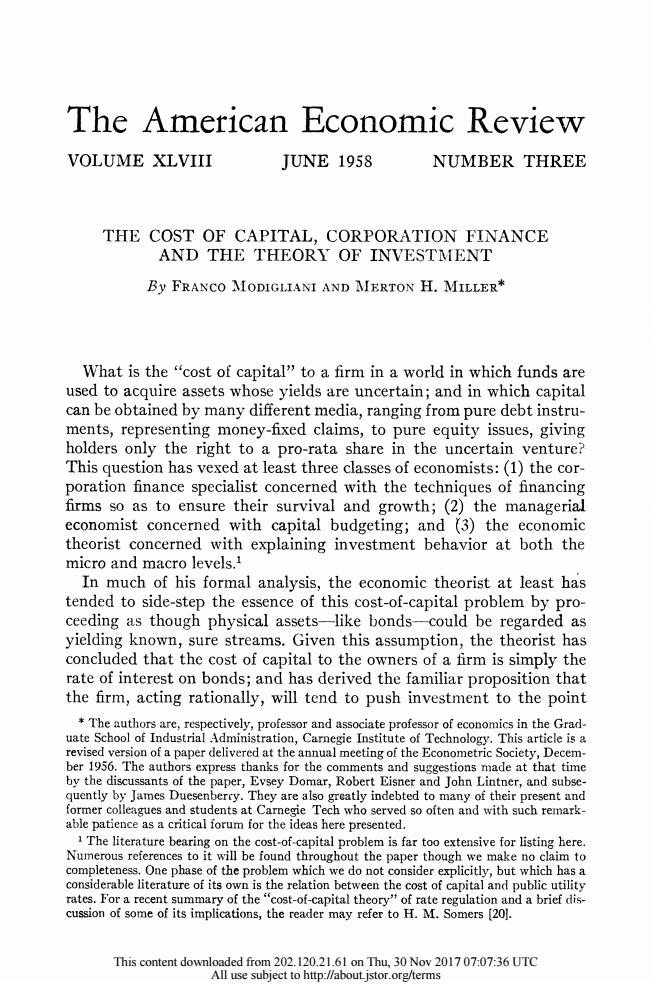正在加载图片...

The American Economic Review VOLUME XLVIII JUNE 1958 NUMBER THREE THE COST OF CAPITAL,CORPORATION FINANCE AND THE THEORY OF INVESTMENT By FRANCO MODIGLIANI AND MERTON H.MILLER* What is the "cost of capital"to a firm in a world in which funds are used to acquire assets whose yields are uncertain;and in which capital can be obtained by many different media,ranging from pure debt instru- ments,representing money-fixed claims,to pure equity issues,giving holders only the right to a pro-rata share in the uncertain venture? This question has vexed at least three classes of economists:(1)the cor- poration finance specialist concerned with the techniques of financing firms so as to ensure their survival and growth;(2)the managerial economist concerned with capital budgeting;and (3)the economic theorist concerned with explaining investment behavior at both the micro and macro levels.1 In much of his formal analysis,the economic theorist at least has tended to side-step the essence of this cost-of-capital problem by pro- ceeding as though physical assets-like bonds-could be regarded as yielding known,sure streams.Given this assumption,the theorist has concluded that the cost of capital to the owners of a firm is simply the rate of interest on bonds;and has derived the familiar proposition that the firm,acting rationally,will tend to push investment to the point The authors are,respectively,professor and associate professor of economics in the Grad- uate School of Industrial Administration,Carnegie Institute of Technology.This article is a revised version of a paper delivered at the annual meeting of the Econometric Society,Decem- ber 1956.The authors express thanks for the comments and suggestions made at that time by the discussants of the paper,Evsey Domar,Robert Eisner and John Lintner,and subse- quently by James Duesenbercy.They are also greatly indebted to many of their present and former colleagues and students at Carnegie Tech who served so often and with such remark- able patience as a critical forum for the ideas here presented. 1 The literature bearing on the cost-of-capital problem is far too extensive for listing here. Numerous references to it will be found throughout the paper though we make no claim to completeness.One phase of the problem which we do not consider explicitly,but which has a considerable literature of its own is the relation between the cost of capital and public utility rates.For a recent summary of the"cost-of-capital theory"of rate regulation and a brief dis- cussion of some of its implications,the reader may refer to H.M.Somers [20J. This content downloaded from 202.120.21.61 on Thu,30 Nov 201707:07:36 UTC All use subject to http://about.jstor.org/termsThe American economic Revlew VOLUME XLVIII JUNE 1958 NUMBER THREE THE COST OF CAPITAL, CORPORATION FINANCE AND THE THEORY OF INVESTMIENT By FRANCO MODIGLIAN1 AND MERTON H. MILLER* What is the "cost of capital" to a firm in a world in which funds are used to acquire assets whose yields are uncertain; and in which capital can be obtained by many different media, ranging from pure debt instru- ments, representing money-fixed claims, to pure equity issues, giving holders only the right to a pro-rata share in the uncertain venture.? This question has vexed at least three classes of economists: (1) the cor- poration finance specialist concerned with the techniques of financing firms so as to ensure their survival and growth; (2) the managerial economist concerned with capital budgeting; and (3) the economic theorist concerned with explaining investment behavior at both the micro and macro levels.' In much of his formal analysis, the economic theorist at least has tended to side-step the essence of this cost-of-capital problem by pro- ceeding as though physical assets-like bonds-could be regarded as yielding known, sure streams. Given this assumption, the theorist has concluded that the cost of capital to the owners of a firm is simply the rate of interest on bonds; and has derived the familiar proposition that the firm, acting rationally, will tend to push investmnent to the point * The authors are, respectively, professor and associate professor of economics in the Grad- uate School of Industrial Administration, Carnegie Institute of Technology. This article is a revised version of a paper delivered at the annual meeting of the Econometric Society, Decem- ber 1956. The authors express thanks for the comments and suggestions made at that time by the discussants of the paper, Evsey Domar, Robert Eisner and John Lintner, and subse- quently by J'ames Duesenberry. They are also greatly indebted to many of their present and former colleagues and students at Carnegie Tech who served so often and with such remark- able patience as a critical forum for the ideas here presented. 1 The literature bearing on the cost-of-capital problem is far too extensive for listing here. Numerous references to it will be found throughout the paper though we make no claim to completeness. One phase of the problem which we do not consider explicitly, but which has a considerable literature of its own is the relation between the cost of capital and public utility rates. For a recent summary of the "cost-of-capital theory" of rate regulation and a brief dis- cussion of some of its implications, the reader may refer to H. M. Somers [201. This content downloaded from 202.120.21.61 on Thu, 30 Nov 2017 07:07:36 UTC All use subject to http://about.jstor.org/terms